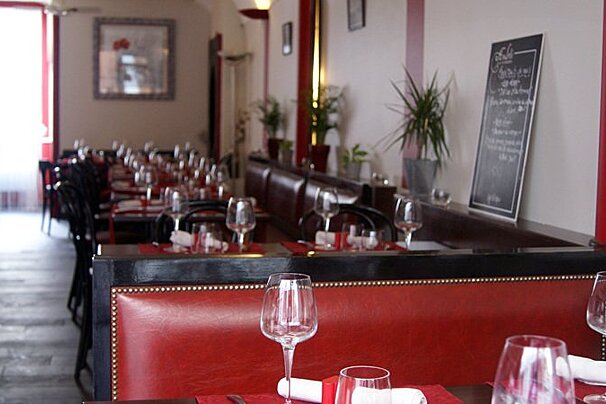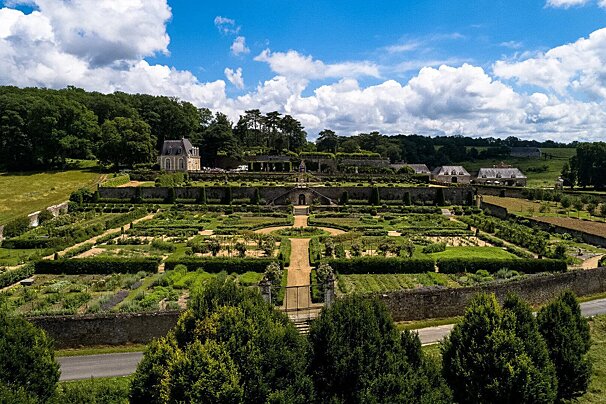
Train Touristique de la Vallee du Loir
This train dating from 1950s travels from Thoré to Trôo taking in troglodyte dwellings, Saint-Rimay tunnel, the town of Montoire and Varennes and more.

© Le Manoir Saint Thomas

© Le Manoir Saint Thomas
Former priory from 12th century
Originally a priory founded in 1107 by the Lord of Amboise, it retains its old character with stained glass windows and dragons on the gables. This small hotel is located in large gardens with century-old lime trees and an inviting outdoor swimming pool.
Each of the 10 personalised rooms come furnished with air conditioning, free WiFi, TV, phone, minibar, safe, hair dryer and a complimentary platter. They are bright and spacious.
A range of massages, beauty treatments and facials are available on request in the room.

This train dating from 1950s travels from Thoré to Trôo taking in troglodyte dwellings, Saint-Rimay tunnel, the town of Montoire and Varennes and more.

In the grounds of the 17th century Château Perrièrre, the golf club is within ancient trees, water features and different plant varieties that create this undulating course offering a diverse round.

Located in the heart of the Sologne, this 27-hole club offers three courses; Sarcelles, Faisans and Chevreuils. You can do 9 holes, combine two courses to do a round of 18, or if you're feeling energetic, you can do all 27!

This 18-hole course is set in the grounds of an 18th-century château which is now a leisure complex with outdoor pool and tennis courts as well as a charming hotel.

This relatively new course, set in beautiful Saumur, is a pleasant 9-hole round if you're searching for a change from historical monuments and châteaux.

This zoo opened in 1946 and is the oldest zoo in France. It is located in a lovely natural environment and gardens. It is one of the most popular attractions by the river Loir and a whole day out for the family.
This restaurant, translated as The Fisherman's Place, offers an excellent selection of predominantly fish dishes served with locally grown vegetables. Christophe Cosme has earned a Michelin star for his dishes in this small spot in Blois.
This fondue house and chocolatier has been running since 1913 serving pastries, macaroons and wonderful hand-made chocolates in its tea house. You can attend a chocolate-making demonstration and workshop.
Young chef David Guitton gained worldwide training before taking on this restaurant in the grounds of the Domaine de la Bergarie winelands.
Charming little coffee shop and lunch spot offering good food on its terrace or tucked away in the cellar. Look out for the decadent dessert selection.

This cute traditional French restaurant in Blois serves good quality food on, as the name suggests, red benches! The dishes are innovative and work well, and the is atmosphere charming.

An Asian-influenced menu in a great setting with beautiful views over the Loire. The fabulous setting was designed by Jean-Pierre Wilmotte. The fabulous menu was created by Jean-Yves Gueho. It has a fabulous wine cellar too. Definitely worth a visit.
This emblematic monument and its landscaped gardens offer one of the most remarkable panoramas of the Loire Valley. A regal heritage, the Château d'Amboise has been home to Charles VII, Louis XI and Charles VIII. The château is registered as a World Heritage site by UNESCO. Still incredibly impressive, the current buildings are just one fifth of the original palace which was destroyed and neglected over the years. Leonardo da Vinci is buried in the Chapel of Saint-Hubert in the château's grounds.
Home to Leonardo da Vinci during his final years, this house was built in the 15th century and was a gift to da Vinci from King François I. The death of Leonardo da Vinci, on 2nd May 1519, marked the end of an era in the history of the Château du Clos Lucé. Today the château is a listed monument and has been restored in an authentic style, displaying an impressive collection of da Vinci's inventions and machines.

Château de Valmer, with its striking park and gardens, nestles on the edge of a hillside overlooking the Brenne Valley, a tributary of the Loire river.

Built on the river Cher, the Château de Chenonceau is the epitome of beauty. Château des Dames, as it is recorded in the French history books, owes a large part of its charm to women.
Dating back to the 14th century, this Renaissance château was home to many royal mistresses. Nowadays it is visited more for its beautiful grounds which include a vegetable garden with a massive 650 varieties of tomato, the contemporary and colourful Dalhia garden and a medicinal garden. It is possible to stay in the château and take cookery classes there.
Château de Chaumont dominates the Loire Valley skyline and is an illustration of both the defensive architecture of its period and the beautiful Renaissance style. In the 18th and 19th centuries, the château, which belonged to Queen Catherine de Medicis and later Diane de Poitiers, knew an intense period of intellectual activity. The Le Ray de Chaumont family welcomed, one after the other, the sculptor Nini, the American Benjamin Franklin and writer Germaine de Staël. The wider Domaine de Chaumont-sur-Loire reached its peak at the end of the 19th century thanks to Prince and Princess de Broglie. The royal couple designed magnificent modern stables, with the help of Maison Hermès, and entrusted Henri Duchêne, the landscape architect, with the creation of a landscaped park. The château is a UNESCO world heritage site.